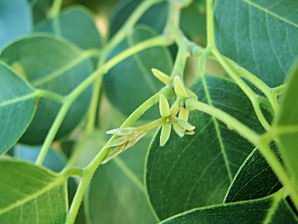Xeriscape Landscaping Plants For The Arizona Desert Environment.
Pictures, Photos, Information, Descriptions,
Images, & Reviews.
Trees.
Indian Rosewood Trees, Dalbergia sissoo.
We Are Proud Of Our SafeSurf Rating!
Click On Any Of The Following Links By Amazon.Com
For Books, & Videos About Wildflowers Of Arizona & The Southwest USA. No Obligation!
 |
| Indian Rosewood Tree, Dalbergia sissoo June 11, 2006. Glendale Arizona Xeriscape Demonstration Library. |
|---|
 | |
| Flowers. Indian Rosewood. Dalbergia sissoo. | Leaves. Indian Rosewood. Dalbergia sissoo. |
|---|---|
 |  |
| Bark. Indian Rosewood. Dalbergia sissoo. | Seed Pods. Indian Rosewood. Dalbergia sissoo. |
 /
/

Indian Rosewood Trees.
We wish to thank Wikipedia, the free encyclopedia for some of the information on this page. We share images and information with Wikipedia. Evergreen to semi-deciduous, large, open, and erect tree with delicate, oval-pointed leaves, requiring a large amount of water. In fact people in Lake Havasu area have had watering difficulty with this plant. Said to be brittle, Could easily break in monsoon storms. In Glendale, Arizona; people do not seem to be experiencing these problems. The Dalbergia sissoo species, or Indian Rosewood, is a deciduous rosewood tree, also known as shisham, sisu, sheesham, tahli, or Irugudujava. It is native to the Indian Subcontinent and Southern Iran. "Indian rosewood" could also refer to another species, Dalbergia latifolia. It is usually found growing along river banks below 3,000 feet in elevation, but can be naturally found up to about 4,300 feet. The temperature in its native range averages 50 �F � 104 �F but varies from just below freezing to 122 �F. In its native environment It can withstand average annual rainfall up to 79 iinches and droughts of about 3 � 4 months. its native soils range from pure sand and gravel to the rich alluvium of river banks; it can grow in slightly saline soils. Its seedlings are intolerant of shade. Second to teak wood, it is the most important cultivated timber tree of the Bihar, which is the largest producer of shisham timber in both India and Pakistan. In the Bihar, the tree is planted on roadsides, along canals and as a common shade tree for tea plantations. It is also commonly planted in the southern Indian cities as a street tree. "Indian rosewood" is a medium to large deciduous tree with a light crown which reproduces by seeds and suckers. It can grow up to a maximum of 82 feet in height with a spread from about 15 to 50 feet, but it is usually smaller. Trunks are often crooked when grown in the open. Leaves are leathery, alternate, pinnately compound and about 5 - 9 inches long. The flowers are whitish to pink, fragrant, nearly sessile, up to about 1/2 inch long and in dense clusters from about 2.0 � 3.9 inches in length. Its seed pods are oblong, flat, thin, belt-like 1.6 � 3.1 inches long, about 0.39 inch wide and light brown in color. They contain 1 � 5 flat bean-shaped seeds about 0.31 � 0.39 inch long. They have a long taproot and numerous surface roots which produce suckers. Their young shoots are drooping; their established stems have light brown to dark gray bark about 0.98 inch thick, shed in narrow strips; their large upper branches support a spreading crown. They usually reproduce by root suckers. The surface roots often grow large in diameter and can become a nuisance. A number of horticulturists rufuse to use this plant for this reason. Their seeds remain viable for only a few months. If you wish to grow a tree from seeds, they should be soaked in water for 48 hours before planting. Only a 60% � 80% germination can be expected in about 1�3 weeks. Seedlings require partial sun or full sun to grow.
Quick Notes:
Height: Up to 40 to 60 feet, spread to 50 feet.
Trunk: The trunk is 2 - 3 feet in diameter.
Bark: Rough grey to brownish grey.
Flowers: Insignificant flowers, exceptionally fragrant white to yellowish white, pea-like, to 2 cm long, nearly sessile; formed in axillary clusters.
Blooming Time: March - April.
Seed Pods: Almost oblong, flat, thin, belt-like 1.6 � 3.1 inches long, about 0.39 inch wide and light brown in color with 1 - 5 seeds.
Seeds: Flat bean-shaped seeds about 0.31 � 0.39 inch long.
Leaves: Leathery, pubescent when young, glabrous later; alternate, to 8 cm long, comprising 3 to 7 leaflets, broadly elliptical to obovate.
Found: Native to the Indian Subcontinent, countries of India, Pakistan, Bangladesh, Sri Lanka, Nepal, & Bhutan. As well as Southern Iran.
Elevation: Native at 3,000 - 4,300 feet.
Hardiness:
Soil pH requirements:
Sun Exposure:
Habitat: Pinyon-juniper woodlands. Also used for Xeriscape landscaping.
Miscellaneous: Flowering Photos Taken: June 11, 2006. Glendale Arizona Xeriscape Demonstration Garden. Considered a Xeriscape Landscaping plant; however it uses a great deal of water.
|



We Are Proud Of Our SafeSurf Rating!
Click On Any Of The Following Links By Amazon.Com
For Books, & Videos About Xerioscape Plants Of Arizona & The Southwest USA. No Obligation!
Back To Arizona Xeriscape Landscaping Main Page.
Back To Xeriscape Trees Page Four.
Back To Arizona Wild Flowers Home Page
Back To DeLange Home Page
© 1966 - Present, Audrey, Eve, & George DeLange
| © 1966 - Present, Audrey, Eve, & George DeLange |

